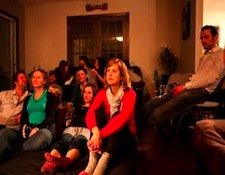It’s the time of year for saving money!

If you are a fan of live acoustic music and you go to usual kind of venues, you’ve probably been disappointed to find that most times what you hear isn’t really purely acoustic, but “sound reinforced.” Even the small coffee house my band plays at regularly has a small and very bad house PA system that is used regularly by most bands that play there.
But there is a recent development in the live music front that has brought forward a new venue for live acoustic music – the house concert.
Simply defined, a house concert is a concert that is held in someone’s home rather than a traditional public commercial space. Obviously, due to the limited space, house concerts are small affairs, rarely having more than fifty people in the room. And, more importantly for acoustic music fans, most house concerts don’t have or need to have sound reinforcement – acoustic instruments are kept purely acoustic.

I’ve attended quite a few house concerts, and except for the occasional electric bass, they’ve all been all-acoustic affairs. The most recent one was at a home in South Boulder, CO, featuring the great roots musician, Andy Statman. His musical styles include a large dose of traditional Jewish and American roots music combined with his own unique way of performing. Andy plays both mandolin and clarinet, and for this concert was joined by his longtime bandmate, Jim Whitney, on acoustic bass.
I also got permission from Mr. Statman to record the concert. I used my Korg MR-1000 set for 5.6 MHz (128x) DSD recording. For ease of set-up I used an Audio Technica AT-825 stereo microphone connected directly to the Korg’s internal microphone preamp rather than my usual Grace Lunatec V-3 microphone preamp and Schoeps Colette M/S microphone rig. I set up my mic stand about five feet away from Statman’s chair, aimed at a point halfway between him and the standup bass, set a level and sat back.
The sound in the very well attended concert was quite well-damped and dry, due in large part to the number of absorbent human bodies in the room. While I wouldn’t call the sound anechoic, the room’s reverb was very limited, giving the recording a moderately aggressive, almost in-your-face perspective, especially when Statman was playing solo clarinet.

Getting the recording levels right was a challenge. On the first tune Statman’s clarinet clipped the microphone levels several times, but after a bit of gain reduction I found the right level setting. A solo clarinet, while not quite as dynamic as a trained soprano voice, still has a wide range, wider than many reproduction systems can handle without a bit of gain adjustment. On several of the solo clarinet pieces, if the playback volume was set during the quiet passages, it needed to be reduced during the fortissimos. When Statman switched to playing mandolin the dynamic range wasn’t nearly as challenging, but on clarinet, look out for flying midrange drivers…
For everyone else in the room during the concert, whose ears weren’t ensconced in earphones, the opportunity to hear a clarinet, mandolin, and acoustic bass without any added electronic augmentation was a treat. I heard several concertgoers comment later about how much more of the music “got” to them, due to the intimacy of the venue.

While I can’t guarantee that every town has someone putting together house concerts, if you look around you can often find people who are doing them in your area. I suggest checking with the local music organizations. Here in Boulder, Colorado the bluegrass, jazz, and old-time music support sites have listings that often include house concerts. But I must warn you, once you’ve attended a couple of house concerts, they may spoil you for regular shows. After spending an evening enjoying real acoustic music played in a small venue, it’s hard to go back to enjoying club and bar sound.





